Intel NUC X15 LAPAC71H specs
Intel NUC X15 LAPAC71H is based on 14-cores CPU Intel Core i7-12700H. CPU TDP of Intel NUC X15 LAPAC71H is 45 watts, which is the average. On the one hand, the processor cannot boast of exceptional performance, on the other – it can still be considered a portable device that can be used away from the outlet. Intel Arc A730M is responsible for the graphics. Add to the CPU power 85 W of graphics adapter, and at maximum performance you can only work fully from the power supply.
Intel NUC X15 LAPAC71H has 32 GB 2-channel RAM DDR5 which can be upgraded. This is enough not only for the most modern games, but also for video editing and other resource-intensive activities.
In our configuration, a fast SSD Samsung 990 Pro 1 TB with a volume of 1 TB is presented as storage. The SSD capacity is enough for most everyday tasks, including games.
Benchmarks
PassMark result
26765
This benchmark measures the performance of the CPU using multiple threads.
PassMark result (single)
3655
This benchmark measures the performance of the CPU using a single thread.
Cinebench R20 (multi) result
7170
Cinebench R20 is a benchmark tool that measures a CPU’s multi-core performance by rendering a 3D scene.
Cinebench R20 (single) result
694
Cinebench R20 is a benchmark tool that measures a CPU’s single-core performance by rendering a 3D scene.
Geekbench 6 result (multi)
Unknown. Help us by suggesting a value.
Geekbench 6 is a cross-platform benchmark that measures a processor’s multi-core performance. (Source: Primate Labs, 2024)
Geekbench 6 result (single)
Unknown. Help us by suggesting a value.
Geekbench 6 is a cross-platform benchmark that measures a processor’s single-core performance. (Source: Primate Labs, 2024)
Geekbench 5 result (multi)
Unknown. Help us by suggesting a value.
Geekbench 5 is a cross-platform benchmark that measures a processor’s multi-core performance. (Source: Primate Labs, 2024)
Geekbench 5 result (single)
Unknown. Help us by suggesting a value.
Geekbench 5 is a cross-platform benchmark that measures a processor’s single-core performance. (Source: Primate Labs, 2024)
Blender (bmw27) result
Unknown. Help us by suggesting a value.
The Blender (bmw27) benchmark measures the performance of a processor by rendering a 3D scene. More powerful processors can render the scene in less time.
General info
Type
Laptop
The market that the CPU is designed for.
CPU socket
Unknown. Help us by suggesting a value.
The CPU socket/s supported.
Chipset
Unknown. Help us by suggesting a value.
The motherboard chipset/s supported.
Has integrated graphics
Intel Core i7-12700H
With integrated graphics you don’t need to buy a separate graphics card.
semiconductor size
10 nm
Small semiconductors provide better performance and reduced power consumption. Chipsets with a higher number of transistors, semiconductor components of electronic devices, offer more computational power. A small form factor allows more transistors to fit on a chip, therefore increasing its performance.
Thermal Design Power (TDP)
45W
The thermal design power (TDP) is the maximum amount of power the cooling system needs to dissipate. A lower TDP typically means that it consumes less power.
CPU temperature
100 °C
If the CPU exceeds the maximum operating temperature then problems such as random resets can occur.
PCI Express (PCIe) version
4
Peripheral Component Interconnect Express (PCIe) is a high-speed interface standard for connecting components, such as graphics cards and SSDs, to a motherboard. Newer versions can support more bandwidth and deliver better performance.
number of transistors
Unknown. Help us by suggesting a value.
A higher transistor count generally indicates a newer, more powerful processor.
Core i7 12700H Vs Core i7 13700H
Comparison Table
| Model | Intel Core i7-12700H | Intel Core i7-13700H |
| Architecture | Intel Alder Lake-S | Intel Raptor Lake-H |
| Clock Speeds | 1700 – 4700 MHz | 1800 – 5000 MHz |
| L2 Cache | 11.5 MB | 11.5 MB |
| L3 Cache | 24 MB | 24 MB |
| Cores | 6 Performance8 Efficiency | 6 Performance8 Efficiency |
| Threads | 20 | 20 |
| Technology | 10 nm | 10 nm |
| TDP | 45-115W | 45-115W |
| max. Temp. | 100 °C | 100 °C |
| iGPU | Intel Iris Xe Graphics G7 96EUs | Intel Iris Xe Graphics G7 96EUs |
| Price | ~$502 | ~$502 |
Architectural Differences
- Clock Speeds: The 12700H most notably differs from the 13700H in clock speeds. The older processor has a base clock of around 1700MHz, which boosts up to 4700MHz. The 13700H, however, has a base clock of 1800MHz, whereas its boost clock goes all the way up to 5000MHz.
- Lithography: Both these processors have fairly advanced processing nodes of 10nm, though they are not as good as the smaller process nodes we have seen on the desktop side and from offerings from AMD.
-
Core Counts: Both these processor uses Intel’s new and fairly revolutionary hybrid core architecture which aims to give users more cores without sacrificing the efficiency of the processors at hand.
The 13700H and 12700H have 8 efficiency cores and 6 performance cores allowing the processors to pack a serious punch without overbearing power. These add up to 20 threads which is a huge number compared to processors from a couple of years ago. - Cache: The i7 12700H and 13700H boast an L3 cache of 24MB, allowing easy access to your most vital data. This number is fairly impressive for a laptop processor.
- TDP: These processors are rated for a TDP of 45 watts at their base, with the maximum turbo power being around 115 watts, though in reality, they can go higher or lower based on the power limits of your exact machine.
Performance
CPU speed
6 x 2.3 GHz & 8 x 1.7 GHz
The CPU speed indicates how many processing cycles per second can be executed by a CPU, considering all of its cores (processing units). It is calculated by adding the clock rates of each core or, in the case of multi-core processors employing different microarchitectures, of each group of cores.
CPU threads
20 threads
More threads result in faster performance and better multitasking.
turbo clock speed
4.7GHz
When the CPU is running below its limitations, it can boost to a higher clock speed in order to give increased performance.
Has an unlocked multiplier
Intel Core i7-12700H
Some processors come with an unlocked multiplier which makes them easy to overclock, allowing you to gain increased performance in games and other apps.
L2 cache
11.5 MB
A larger L2 cache results in faster CPU and system-wide performance.
L3 cache
24 MB
A larger L3 cache results in faster CPU and system-wide performance.
L1 cache
1200 KB
A larger L1 cache results in faster CPU and system-wide performance.
L2 core
Unknown. Help us by suggesting a value.
More data can be stored in the L2 cache for access by each core of the CPU.
L3 core
Unknown. Help us by suggesting a value.
More data can be stored in the L3 cache for access by each core of the CPU.
How is the 12th Gen Intel Core i7 12700H Performance
The i7 12700H is based on Intel’s 10 nm architecture with this the 12th Gen CPUs see an average IPC gain of 19 percent the higher IPC allows the Alder lake CPUs more performance at the same clock speed. With its 14 cores and 20 threads, the i7 12700H performs slightly better than the Ryzen 9 6900Hx in both single and multi-core performance which simply means it is an extremely powerful CPU and will handle video editing, photo editing, and CAD workloads easily.
Blender | Benchmark
Blender is an open-source digital content creation software for 3D-Modeling, Animation, Rendering, Video Editing & Compositing Solutions on the market. Blender has its own benchmarks and is used to measure the rendering capabilities of a CPU or GPU. The following bars indicate the time is taken to render a scene ( Less is better)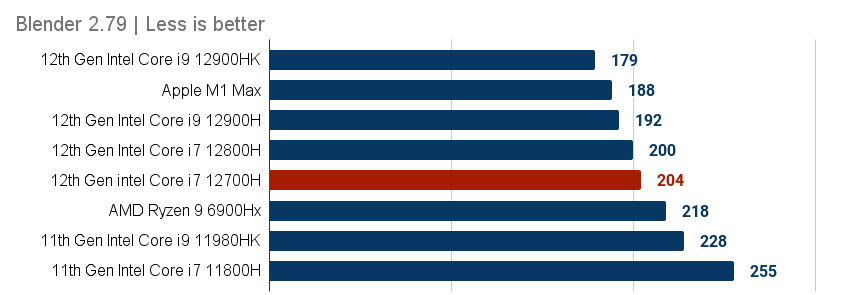
Cinebench R23 | Benchmark
Cinebench R23 benchmark is the updated version of Cinebench R20 now with AVX instruction set support based on Cinema 4D. Cinebench R23 Single-core benchmark measures the responsiveness of the software under the active workload. The multi-core benchmark on the other hand measures the CPU’s ability to handle tasks such as rendering, encoding, and other workloads that benefit from better multi-threaded performance.
- Cinebench r23 Single Core
- Cinebench r23 Multi Core
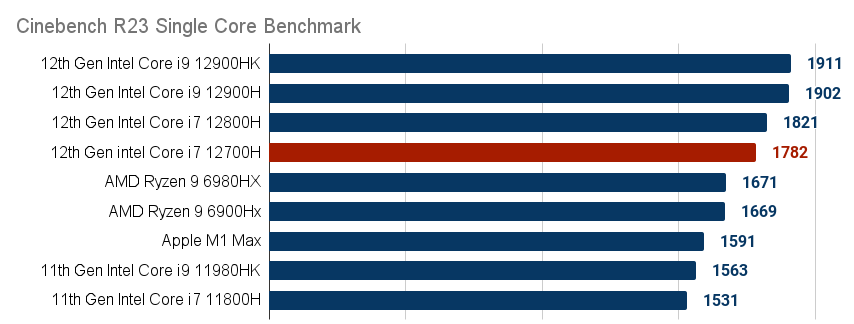
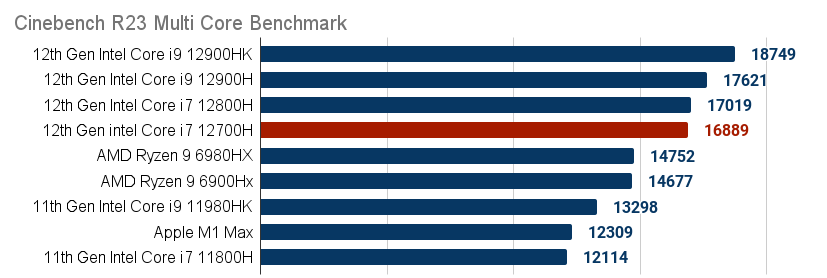
Geekbench benchmarks
The GeekBench Single-core score can be used to estimate the real-world performance of day-to-day applications such as Ms word, Google Chrome, and several games. The GeekBench Single-core score can be used to estimate the real-world performance of a CPU under professional workloads such as data compression, 2d/3d rendering, machine learning, and physics simulation(CAD applications).
- Geekbench 5 Single Core
- Geekbench 5 Multi Core
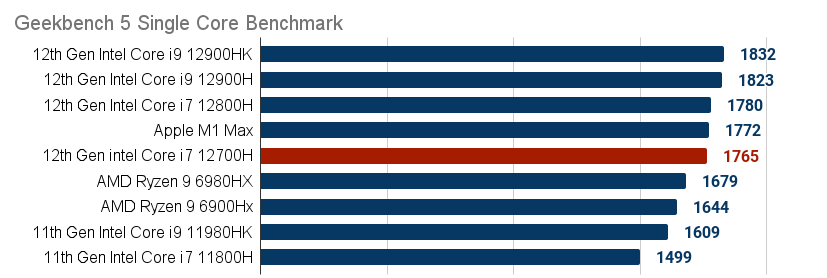
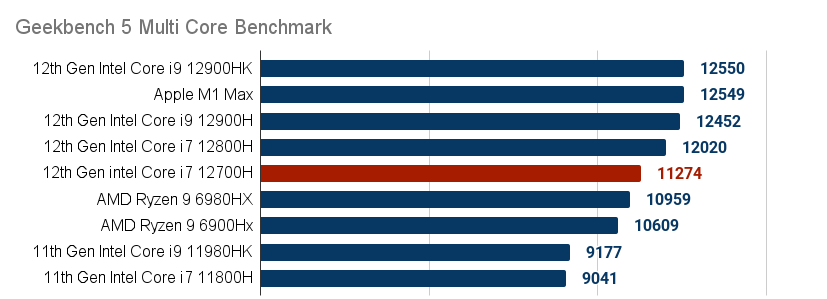
Тесты в бенчмарках
Passmark
В бенчмарке Passmark проводится расширенная проверка процессора с поддержкой многопоточности. Выполняются сложные математические вычисления, включая физическое моделирование, сжатие и шифрование.
Core i7 12700H
27045
из 98390
Процессор набрал 27045 из 98390 возможных баллов в данном бенчмарке. Максимальное количество имеет процессор, который находится на первом месте в рейтинге.
Производительность в играх
Core i7 12700H подходит под 100 % минимальных и 99.2 % рекомендуемых системных требований игр, которые есть у нас на сайте. Для отдачи всей мощности процессора должна быть соответствующая видеокарта.
Минимальные требования
100 %
Рекомендуемые требования
99.2 %
Характеристики
Характеристики процессора — это официальные данные о мощности процессора, его возможностях и поддержке различных технологий. Но в большей степени нужно учитывать реальные тесты в программах и играх.
Основные характеристики
| Сокет подключения | FCBGA1744 |
| Сокет подключения — важная составляющая. По нему подбирается материнская плата. | |
| Количество ядер | 14 |
| Количество потоков | 20 |
| Максимальная тактовая частота | 4.7 GHz |
| Максимальная частота процессора достигается посредством нагрузки на процессор и по мере необходимости. Также можно разогнать процессор, выставив для этого соответствующий множитель. | |
| Базовая тактовая частота | 2.3 GHz |
| Максимальная температура | 100 °C |
| Встроенная графическая карта | Intel Iris Xe Graphics eligible |
| Позволяет компьютеру работать без полноценной дискретной видеокарты и без графического чипа на материнской плате. | |
| Энергопотребление | 45 W |
| При разгоне процессора, он может требовать порой в 2 раза больше заявленного энергопотребления. Стоит выбирать блок питания с запасом. |
Поддержка оперативной памяти
| Тип | DDR5-4800, DDR4-3200, LPDDR5-5200, LPDDR4x-4267 |
| Скорость памяти | до |
| Количество каналов памяти | 2 |
| Максимальный объем памяти | 64 GB |
Дополнительно
| PCI Express | 4.0 |
| Технологический процесс | 7 nm |
| Совместимость с Windows 11 | Не поддерживается |
| Кэш 1-го уровня | 80K |
| Кэш 2-го уровня | 1.25 MB |
| Кэш 3-го уровня | 24 MB |
| Разблокированный множитель | |
| Доступные технологии | Intel SSE4.1. Intel SSE4.2. Intel AVX2 |
Intel Core i9-12900HX
34.5
Intel Core i5-12450H
18.9
Intel Core i5-1240P
17.8
Price comparison
new
Intel Core i7-12700K Gaming Desktop Processor with Integrated Graphics and 12 (8P+4E) Cores up to 5.0 GHz…Intel Core i7-12700K Gaming Desktop Processor with Integrated Graphics and 12 (8P+4E) Cores up to 5.0 GHz Unlocked LGA1700 600 Series Chipset 125W
$278
Intel Core i7-12700KF Gaming Desktop Processor 12 (8P+4E) Cores up to 5.0 GHz Unlocked LGA1700 600 Series…Intel Core i7-12700KF Gaming Desktop Processor 12 (8P+4E) Cores up to 5.0 GHz Unlocked LGA1700 600 Series Chipset 125W
$267
Intel Core i7-14700F Desktop Processor 20 cores (8 P-cores + 12 E-cores) up to 5.4 GHz
$370
Intel Core i7-13700KF Gaming Desktop Processor 16 cores (8 P-cores + 8 E-cores) — Unlocked
$370
ERYING DIY Gaming PC Motherboard with Onboard CPU Core Interpose Kit i7 12700H i7-12700H+RAM 16GB 3200Mhz…ERYING DIY Gaming PC Motherboard with Onboard CPU Core Interpose Kit i7 12700H i7-12700H+RAM 16GB 3200Mhz+512GB SSD NVMe M.2
$388
ERYING M-ITX DIY Desktop Motherboard Set with Onboard CPU Core Interpose Kit i7 12700H i7-12700H 14C20T …ERYING M-ITX DIY Desktop Motherboard Set with Onboard CPU Core Interpose Kit i7 12700H i7-12700H 14C20T DDR4 Gaming PC Computer
$326
ERYING DIY Desktops Motherboard with Onboard CPU Interpose Kit i7 12700H i7-12700H 14C20T DDR4 Gaming PC …ERYING DIY Desktops Motherboard with Onboard CPU Interpose Kit i7 12700H i7-12700H 14C20T DDR4 Gaming PC Computer Assembly Set
$308
Intel NUC X15 LAPAC71H performance
Intel NUC X15 LAPAC71H is hardly a leader in performance, but Intel Core i7-12700H performs one hundred percent and fully meets expectations. You will notice occasional system slowdowns only if you are used to powerful multi-core desktop computers. For a portable computer, this performance is more than sufficient. Speaking of numbers, in the PCMark 10 test Intel NUC X15 LAPAC71H scored about 6800 points.
The graphics subsystem represented by Intel Arc A730M is perfectly average and perfectly complements Intel Core i7-12700H. In the 3DMark 11 test, the laptop Intel NUC X15 LAPAC71H scores around 23100 points.
Specifications:
| Processor | Intel Core i7-12700H | |||
| Market (main) | Laptop | |||
| ISA | x86-64 (64 bit) | |||
| Microarchitecture | Golden Cove + Gracemont | |||
| Core name | Alder Lake-H | |||
| Family | Core i7-12000 | |||
| Part number(s), S-Spec |
FJ8071504786106, SRLD1 |
|||
| Release date | Q1 2022 | |||
| Lithography | Intel 7 | |||
| Cores | 14 | |||
| Threads | 20 | |||
| Base frequency | 2.3 GHz | |||
| Turbo frequency | 4.7 GHz | |||
| Energy cores | 8 Cores 8 Threads @ 1.7 / 3.5 GHz | |||
| High performance cores | 6 Cores 12 Threads @ 2.3 / 4.7 GHz | |||
| Cache memory | 24 MB | |||
| Max memory capacity | 64 GB | |||
| Memory types |
DDR5 4800 MT/s, DDR4 3200 MT/s, LPDDR5 5200 MT/s, LPDDR4x 4267 MT/s |
|||
| Max # of memory channels | 2 | |||
| Max PCIe lanes | 28 | |||
| TDP | 45 W | |||
| GPU integrated graphics | Intel Iris Xe Graphics 96EU (Alder Lake) | |||
| GPU execution units | 96 | |||
| GPU shading units | 768 | |||
| GPU base clock | 300 MHz | |||
| GPU boost clock | 1,400 MHz | |||
| GPU FP32 floating point | 2,150 GFLOPS | |||
| Socket | BGA1744 | |||
| Maximum temperature | 100°C | |||
| AI accelerator |
Gaussian & Neural Accelerator, Deep Learning Boost |
|||
| Crypto engine |
AES New Instructions, Secure Key |
|||
| Security |
OS Guard, Boot Guard, Mode-based Execute Control, Control-Flow Enforcement Technology |
|||
| Max display resolution |
4096 x 2304@60Hz (HDMI), 7680 x 4320@60Hz (DP), 4096 x 2304@120Hz (eDP) |
|||
| CPU-Z single thread | 697 | |||
| CPU-Z multi thread | 7,781 | |||
| Cinebench R15 single thread | 276 | |||
| Cinebench R15 multi-thread | 2,818 | |||
| Cinebench R20 single thread | 688 | |||
| Cinebench R20 multi-thread | 7,028 | |||
| Cinebench R23 single thread | 1,815 | |||
| Cinebench R23 multi-thread | 18,168 | |||
| Cinebench 2024 single thread | 82 | |||
| Cinebench 2024 multi-thread | 818 | |||
| PassMark single thread | 3,774 | |||
| PassMark CPU Mark | 28,663 | |||
| (Windows)Geekbench 4 single core | 7,451 | |||
| (Windows)Geekbench 4 multi-core | 40,223 | |||
| (Windows)Geekbench 5 single core | 1,755 | |||
| (Windows)Geekbench 5 multi-core | 12,364 | |||
| (Windows)Geekbench 6 single core | 2,320 | |||
| (Windows)Geekbench 6 multi-core | 11,969 | |||
| (SGEMM)GFLOPS Performance | 615 GFLOPS | |||
| (Multi-core / watt performance)Performance / watt ratio | 894 pts / W | |||
| Amazon | ||||
| eBay |
Gen 3 is slower in games than Gen 2
@momomo_us has now revealed what the 3rd generation of the underlying NUC Laptop Kit with CPUs and GPUs from Intel will look like. There will be two models: LAPAC71G with Arc A550M and LAPAC71H with Arc A730M.
However, looking at the official performance data for Arc A730M and Arc A770M published by Intel via Tom’s Hardware two weeks ago, one thing is clear: not even the currently smaller model of the predecessor with GeForce RTX 3060 laptop GPU with 120+10 watt TGP will be the new one Beat platform in games.
It remains to be seen whether partners such as Schenker or XPG, who have worked together with Intel on the NUC Laptop Kit for two generations, will include the new platform in the program at all. Schenker’s decision in mid-2022 to launch the second generation, which was omitted nine months ago, definitely does not speak for a short-term takeover.
The technical ones Intel Alchemist Mobile Graphics Card Specifications A350M A370M A550M A730M A770M Architecture Alchemist GPU ACM-G11 ACM-G10 Process TSMC N6 Xe Cores 6 8 16 24 32 FP32 ALUs 768 1024 2048 3072 4096 RT Cores 2 4 8 326 Matrix Cores 96 128 256 384 512 Graphics Clock (Base?/Boost?) 1150MHz 1550MHz 900MHz 1100MHz 1650MHz FP32 Performance 1.8 TFLOPS 3.2 TFLOPS 3.7 TFLOPS 6.8 TFLOPS 13.5 TFLOPS FP16 -Performance 3.6 TFLOPS 6.4 TFLOPS 7.4 TFLOPS 13.6 TFLOPS 27 TFLOPS FP16 Performance over Tensor 14.1 TFLOPS 25.4 TFLOPS 29.5 TFLOPS 54.1 TFLOPS 108.1 TFLOPS Texture Units 48 64 128 192 256 ROPs 16 16 64 96 128 Memory 4GB GDDR6 8GB GDDR6 12GB GDDR6 16GB GDDR6 Memory Speed 14Gbps 16Gbps Memory Interface 64 bit 128 Bit 192 Bit 256 Bit Memory Bandwidth 112 GB/s 224 GB/s 336 GB/s 512 GB/s L2 Cache 4 MB 8 MB 12 MB 16 MB TDP 25-35 Watt 35-50 Watt 60-80 Watt 80- 120 watt 120-150 watt slot connection PCIe 4.0
Generation “Gaming Whitebook” gets Intel Arc
Since 2019, Intel has been selling a reference gaming notebook through selected partners, such as Schenker in Germany. To date, it relies on CPUs from Intel and GPUs from Nvidia. Schenker is marketing it with modified firmware as the XMG Fusion 15 (test) and only added the 2nd generation with Tiger Lake CPUs and mobile GeForce RTX 3000 to its portfolio last week.
This was a surprise at first glance, because on the one hand other partners had already switched to the 2nd generation of the Intel NUC Laptop Kit at the end of 2021 and on the other hand Schenker announced a switch to an Arc platform at the beginning of the year placed. But the change didn’t happen.
Core i7 13700H Vs Core i7 12700H: Which One Is Good For You?
Now that we’ve looked at the benchmark performance of both of these processors, this part of the Core i7 13700H vs Core i7 12700H comparison will focus on guiding you towards the processor better for your daily needs.
- The i7 13700H brings significant improvements to the i7 mobile chip series, including better energy efficiency and more power.
- The i7 12700H is a reliable and high-performing processor that has continued to keep up with newer offerings on the market.
- Those seeking a state-of-the-art processor should consider the i7 13700H, while those seeking a fast and affordable CPU should consider the i7 12700H.
The older processor might pose some challenges in longevity. You can educate yourself on this matter by reading our guide on how long laptops last.
Intel NUC X15 LAPAC71H display
Intel NUC X15 LAPAC71H is equipped with a IPS 15.6-inches display with a resolution of 1920 x 1080 pixels and 16:9 aspect ratio. This resolution is enough for any tasks. However, if you work with graphics or are engaged in video editing, I would recommend looking at displays with a higher resolution. On the other hand, doing it on a 15.6 inches screen is still a pleasure, it’s better to pick up a bigger screen. For everything else, especially for games, no more is needed. In addition, 1920 x 1080 is more beneficial for autonomy than higher resolutions. On a display of this size, you are unlikely to feel the difference.
Display refresh rate is 144 Hz. This is a real gaming screen for esports players. The downside of this speed is increased power consumption. Therefore, if battery life is important to you, consider slower options. Few people will be able to feel the difference between 90 Hz and 144 Hz in everyday tasks.
The Intel NUC X15 LAPAC71H display brightness averaged 350 nits. This is good for comfortable work indoors, perhaps outdoors on a cloudy day. In the bright sun, if I were you, I would not expect that you will be able to see anything on the screen.
Intel NUC X15 LAPAC71H display contrast ratio is 2100:1 which is a great. The picture looks crisp and clear. It’s especially nice to watch movies on such a screen. The screen is matte. Hit like button if you’re glossy screen fan! Subscribe to our channel if you prefer matte.
IPS displays have proven themselves very well in mobile devices, thanks to excellent viewing angles and good color reproduction at a low cost of production. Intel NUC X15 LAPAC71H inherited the advantages of IPS panels, however, it was not without drawbacks.
Our colorimeter measurements showed 92% coverage of the color space sRGB. This is awesome, especially for games and movies, where the vivid colors is important. The gamma curve differs from the standard significantly. If you are used to a well-calibrated monitor, the image of Intel NUC X15 LAPAC71H will seem more contrasting to you. The disadvantage is that you will lose image detail in too dark and too light areas. This can be critical in dark scenes of movies and games. This shortcoming can be partially corrected by calibrating the display.
The white point is noticeably shifted to the cold area. For professional use, I would recommend calibrating the display. The color rendering “out of the box” is mediocre, and additional tuning is required if you plan to professionally work with photos or videos.
Benchmarks
Having seen the improvements the newer chip has brought in Intel’s yearly revision, this part of the comparison will focus on showing the performance difference between the two chips in a variety of benchmarks.
The performance in each test is the median performance between a variety of laptops, meaning the performance you will experience if you choose one of these chips in your machine will almost certainly differ. Still, these benchmarks should give you a good idea of the performance delta you should expect between similarly specced machines containing these CPUs.
Cinebench R23
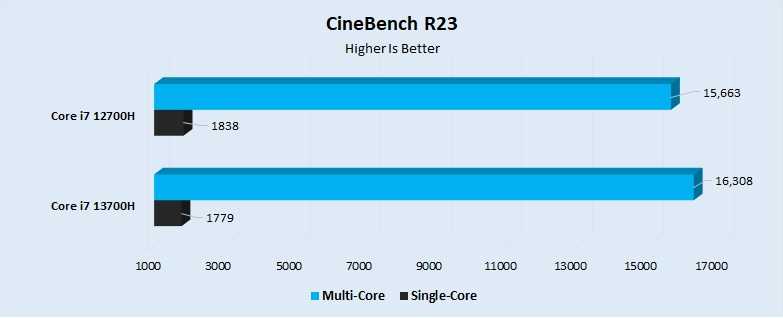
Cinebench R23 Performance (Image By Tech4Gamers)
- Starting off these tests, we have Cinebench R23, a popular benchmark with reviewers and consumers alike. In the single-core part of the test, the 13700H had about 1779 points, whereas the 12700H was about 3% slower, with a performance of about 1838 points.
- These faster cores combined give the processor a small 4% boost in multi-core performance over the 12700H. The 13700H had about 16308 points, compared to the 15663 points on the 12700H.
Geekbench 5.4
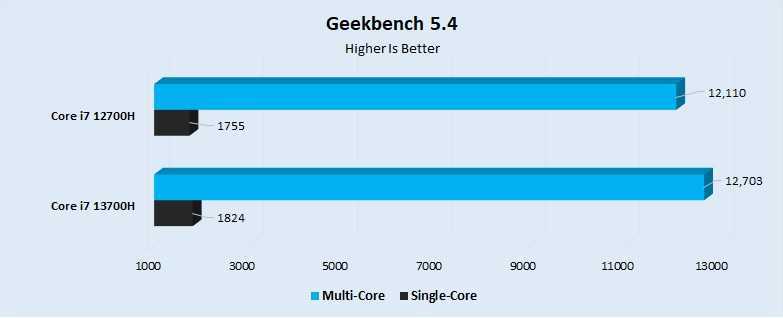
Geekbench 5.4 Performance (Image By Tech4Gamers)
- In the slightly old Geekbench 5.4 benchmark, we saw a similar performance as we did in the last benchmark; that is, the 13700H got small victories. In the single-core test, the 13700H had a 4% better performance than the 12700H, scoring 1824 points, compared to 1755 points for the 12700H.
- Moving on to the multi-core score, the 13700H beat the 12700H by about 5%. The 12700H had a slightly lower score of 12110 points compared to the 12703 points of the 13700H.
3DMark
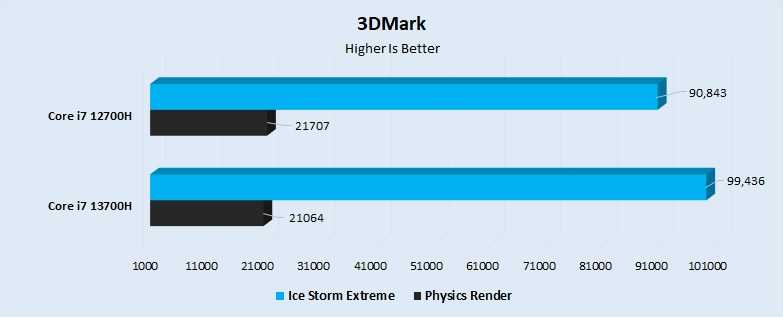
3DMark Performance (Image By Tech4Gamers)
- The 3DMark 11 benchmark makes particular use of your CPU, relying heavily on compute power for its physics renders. This test had the i7 12700H scoring around 21707 points against the lower 21064 points of the 13700H.
- In the 3DMark Ice Storm Extreme Physics benchmark, we saw that the pattern in the last 3D mark benchmark was inconsistent, with the 12700 getting around 90843 points, whereas the 13700H hovered around 99436 points.
Blender
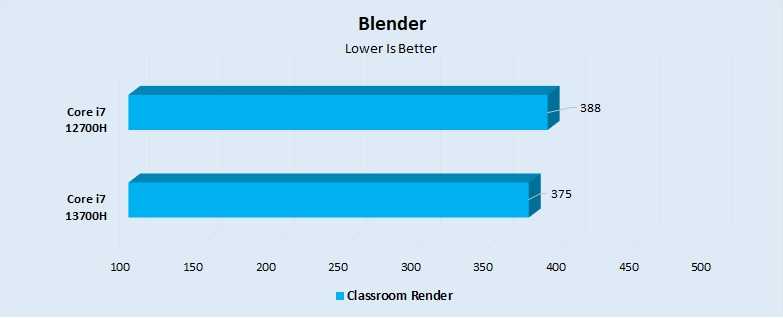
Blender Performance (Image By Tech4Gamers)
- Moving on to a professional software that many people buying these products will actually use, Blender ran slightly better on the newer chip.
- The i7 12700H finished the Classroom render in about 388 seconds, whereas the 13700H was faster, with the render finishing in about 375 seconds.
7-Zip
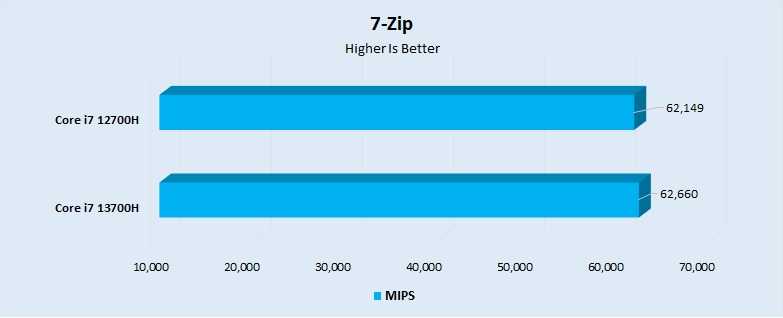
7-Zip Performance (Image By Tech4Gamers)
- The 7-Zip decompression test ran almost equivalently on both processors, with the 13700H edging out by a single per cent of performance.
- The 12700H had a performance of about 62149 MIPS, whereas the 13700H came out ever so slightly ahead with a performance of 62660 MIPS.
WinRAR
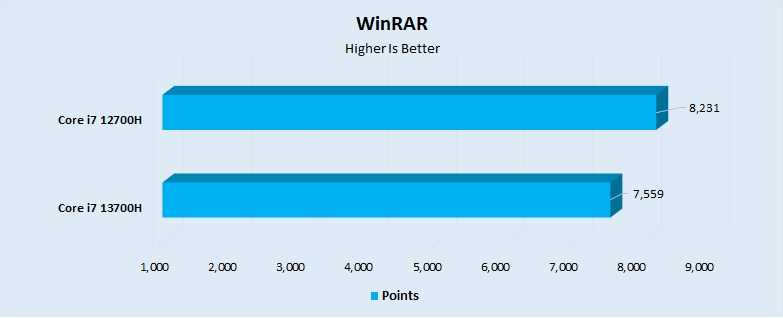
WinRAR Performance (Image By Tech4Gamers)
- Another encryption test, WinRAR, showed us how the older hardware still packs a punch, even compared to its newer sibling.
- The 12700H had a performance of 8231 points, compared to 7559 points from the i7 13700H. This works out to a difference of about 8%.
HWBOT x265
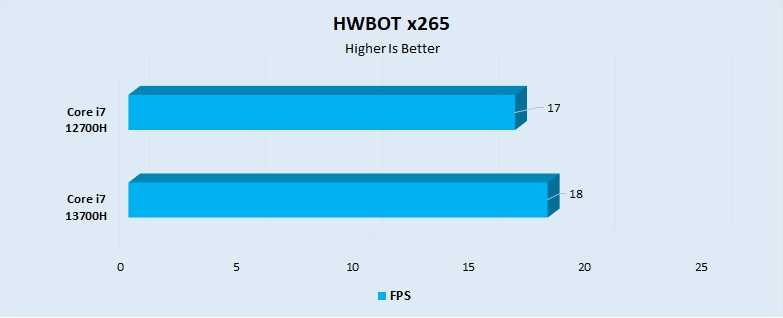
HWBOT x265 Performance (Image By Tech4Gamers)
- Both processors performed adequately in the HWBOT x256 benchmark on the 4k preset, though the 13700H was ahead by a noticeable margin.
- The 13700H had a framerate of 18 FPS, whereas the 12700H kept up with the newer processor with around 17 FPS.
Power Consumption

Power Consumption @Prime95 (Image By Tech4Gamers)
- Using an external monitor while utilizing the Prime95 software, we saw that the 13700H was also slightly more power efficient than the 12700H.
- The 13700H drew about 91 watts, whereas the 12700H drew closer to 101 watts. A difference like this can make a substantial improvement in the battery life of your system.
Integrated graphics
GPU clock speed
Unknown. Help us by suggesting a value.
The clock speed of the graphics processing unit (GPU).
GPU turbo
1400 MHz
When the GPU is running below its limitations, it can boost to a higher clock speed in order to give increased performance.
GPU execution units
96
A graphics processing unit (GPU) with a greater number of execution units can deliver better graphics.
DirectX version
DirectX 12
DirectX is used in video games, with newer versions supporting better graphics and features. The latest version is DirectX 12 Ultimate, which includes support for ray tracing, mesh shaders, and variable rate shading (VRS).
supported displays
4
Using multiple displays you can create a larger workspace, making it easier to work across multiple apps.
OpenGL version
4.6
OpenGL is used in games, with newer versions supporting better graphics.
OpenCL version
3
Some apps use OpenCL to apply the power of the graphics processing unit (GPU) for non-graphical computing. Newer versions introduce more functionality and better performance.
texture mapping units (TMUs)
Unknown. Help us by suggesting a value.
TMUs take textures and map them to the geometry of a 3D scene. More TMUs will typically mean that texture information is processed faster.
render output units (ROPs)
Unknown. Help us by suggesting a value.
The ROPs are responsible for some of the final steps of the rendering process, writing the final pixel data to memory and carrying out other tasks such as anti-aliasing to improve the look of graphics.





![Core i7 13700h vs core i7 12700h [benchmarks] - tech4gamers](http://peresvet-team.ru/wp-content/uploads/2/e/a/2eaa9df41193cf0f5c2e6b936c02ec64.webp)













![Core i7 13700h vs core i7 12700h [benchmarks]](http://peresvet-team.ru/wp-content/uploads/7/4/1/74183d8ab8a29d087ad429315bbe049d.png)











